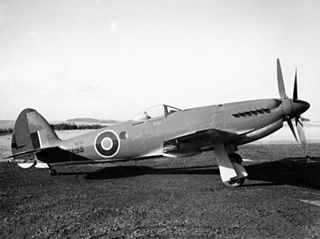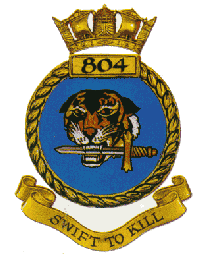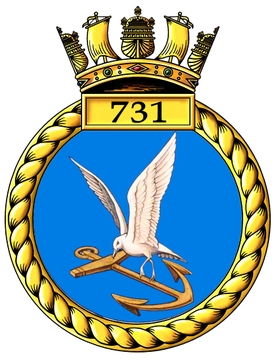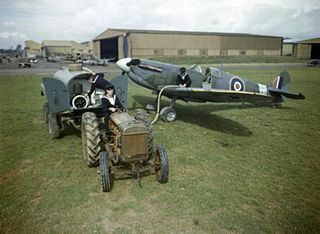
The Supermarine Seafire is a naval version of the Supermarine Spitfire adapted for operation from aircraft carriers. It was analogous in concept to the Hawker Sea Hurricane, a navalised version of the Spitfire's stablemate, the Hawker Hurricane. The name Seafire was derived from the abbreviation of the longer name Sea Spitfire.

The Supermarine Walrus is a British single-engine amphibious biplane designed by Supermarine's R. J. Mitchell at their works at Woolston, Southampton. Primarily used as a maritime patrol aircraft, it was the first British squadron-service aircraft to incorporate an undercarriage that was fully retractable, crew accommodation that was enclosed, and a fuselage completely made of metal.

The Supermarine Attacker is a British single-seat naval jet fighter designed and produced by aircraft manufacturer Supermarine for the Royal Navy's Fleet Air Arm (FAA). It was the first jet fighter to enter operational service with the FAA.

Royal Naval Air Station Lee-on-Solent,, is a former Royal Naval Air Station located near Lee-on-the-Solent in Hampshire, approximately 4 miles (6.44 km) west of Portsmouth, on the coast of the Solent.

The Supermarine Spiteful was a British fighter aircraft designed by Supermarine during the Second World War as a successor to the Spitfire. Powered by a Rolls-Royce Griffon engine, it had a radical new wing design to allow safe operations at higher speeds and incorporating inwards-retracting undercarriage. Other changes included a larger fin to improve the marginal stability of Griffon Spitfires. Development of the wing was formalised by Air Ministry specification F.1/43; as well as a new aircraft, there was an expectation the wing could be used as a replacement for the elliptical wing on Spitfire production.

The Supermarine Seafang was a British Rolls-Royce Griffon–engined fighter aircraft designed by Supermarine to Air Ministry specification N.5/45 for naval use. It was based on the Spiteful, which was a development of Supermarine's Griffon-engined Spitfire aircraft. By that time the Spitfire was a 10-year-old design in a period of rapid technical development in aviation. The Seafang was outmoded by jet aircraft, and only 18 were built.

The Blackburn Firebrand was a British single-engine strike fighter for the Fleet Air Arm of the Royal Navy designed during World War II by Blackburn Aircraft. Originally intended to serve as a pure fighter, its unimpressive performance and the priority allocation by the Ministry of Aircraft Production of Napier Sabre engines to the Hawker Typhoon caused it to be redesigned with an alternate engine as a strike fighter to take advantage of its load-carrying capability. Development was slow and the first production aircraft was not delivered until after the end of the war. Only a few hundred were built before it was withdrawn from front-line service in 1953.

The Supermarine Sea Otter was an amphibious aircraft designed and built by the British aircraft manufacturer Supermarine. It was the final biplane flying boat to be designed by the company, and the last biplane to enter service with both the Royal Navy and the Royal Air Force (RAF).
The Supermarine Type 224 was a British gull-wing monoplane fighter aircraft designed by R.J. Mitchell at Supermarine in response to Air Ministry Specification F.7/30, which sought to introduce a new fighter to succeed the Gloster Gauntlet. The Type 224 was powered by a Rolls-Royce Goshawk engine, which used an experimental evaporative cooling system.

804 Naval Air Squadron was a Naval Air Squadron of the Royal Navy, formed in November 1939 from part of 769 NAS Sea Gladiators which had been detached to RNAS Hatston. The squadron was merged into 800 NAS in June 1944 and subsequently reformed in September.

807 Naval Air Squadron was a Naval Air Squadron of the Royal Navy.

Royal Naval Air Station Burscough, was a Fleet Air Arm (FAA) naval air station which was 1.5 miles (2.4 km) southwest of Burscough, Lancashire. The Admiralty acquired 650 acres (2.6 km2) of land in December 1942 and the airfield was built with four narrow runways and several hangars, being commissioned on 1 September 1943.

The Supermarine Type 525 was a British prototype naval jet fighter aircraft of the 1950s.

708 Naval Air Squadron was a Naval Air Squadron of the Royal Navy's Fleet Air Arm which disbanded during February 1946. It formed during October 1944 at HMS Daedalus, RNAS Lee-on-Solent, as the Firebrand Tactical Trials Unit, before moving to nearby RAF Gosport the following January. Tasked with looking into issues distinct to the Blackburn Firebrand the unit also performed deck landing training and torpedo exercises with the aircraft. The squadron moved to RNAS Ford where a number of personnel including the CO provided the core for the formation of 813 Naval Air Squadron, the Fleet Air Arm’s initial operational Blackburn Firebrand unit. The squadron relocated to RNAS Fearn at the beginning of December and then in January 1946 it moved to RNAS Rattray.

709 Naval Air Squadron was a Naval Air Squadron of the Royal Navy's Fleet Air Arm which last disbanded during January 1946. It formed in September 1944 within the School of Naval Air Warfare as the Ground Attack School using both the British Supermarine Seafire and the American Grumman Hellcat fighter aircraft for training. The squadron spent its whole sixteen month existence based at HMS Vulture, Royal Naval Air Station St. Merryn.

730 Naval Air Squadron was a Naval Air Squadron of the Royal Navy's Fleet Air Arm. It was active between 1944 and 1945 as a Communications Squadron. The squadron was formed and operated out of RNAS Abbotsinch from April to November 1944, by that point in time it operated four types of aircraft. It moved to RNAS Ayr and while there gained two more aircraft types. For the first three months of 1945 a detachment operated out of RNAS Machrihanish, however, the squadron remained at RNAS Ayr until disbanding in August 1945.

731 Naval Air Squadron was a Naval Air Squadron of the Royal Navy's Fleet Air Arm (FAA). It was active between 1943 and 1945 and its sole role throughout its formation was a Deck Landing Control Officer training squadron. Through this role the squadron pilots were nicknamed 'Clockwork Mice'. It was based out of the purpose built airbase, commissioned as HMS Peewit, known as Royal Naval Air Station East Haven, in Scotland, as part of the Deck Landing Training School there.

761 Naval Air Squadron was a Naval Air Squadron of the Royal Navy's Fleet Air Arm. It was formed at HMS Heron, RNAS Yeovilton, as the Advanced Training Squadron of the Fleet Fighter School, in 1941. The squadron moved to HMS Dipper, RNAS Henstridge, in 1943, as part of the No. 2 Naval Air Fighter School. It remained at HMS Dipper and in this role, until January 1946, when the squadron disbanded.

772 Naval Air Squadron was a Naval Air Squadron of the Royal Navy's Fleet Air Arm which last disbanded during September 1995. 772 Naval Air Squadron formed as a Fleet Requirements Unit out of ‘Y’ Flight from 771 Naval Air Squadron at RNAS Lee-on-Solent in September 1939. While the headquarters remained there, floatplanes were operated out of RNAS Portland, however, mid 1940 saw the whole squadron move north to RNAS Campbeltown and roughly twelve months afterwards the short distance to RNAS Machrihanish. The unit moved to RNAS Ayr in July 1944 and became the Fleet Requirements Unit School. In January 1946 the squadron moved to RNAS Burscough in Lancashire, before moving to RNAS Anthorn in Cumberland, in May. It became the Northern Fleet Requirements Unit upon moving to RNAS Arbroath, in June 1947, but disbanded into 771 Naval Air Squadron in October. 772 Naval Air Squadron reformed as a Helicopter Support Squadron at RNAS Portland in September 1974. In September 1977 the squadron took over responsibility for a number of Ships' Flights of Royal Fleet Auxiliary ships. The squadron was used to reform 848 Naval Air Squadron for the Falklands Task Force in 1982, with the Ships' Flights absorbed into 847 Naval Air Squadron. In August 1982 it took on the Anti-Submarine Warfare Flight from 737 Naval Air Squadron and between 1983 - 1985 a Search and Rescue Flight operated out of RNAS Lee-on-Solent.

Royal Naval Air Station Twatt, is a former Royal Navy Air Station located near Twatt, Orkney, Scotland. It was built by the Admiralty and was commissioned on 1 April 1941. On 1 January 1942 it became an independent command as HMS Tern. The airbase was designed to provide accommodation for disembarked Front-Line squadrons and accommodation for disembarked Ship's Flight Aircraft and was home to the Home Fleet Fleet Requirements Unit, 771 Naval Air Squadron.





















